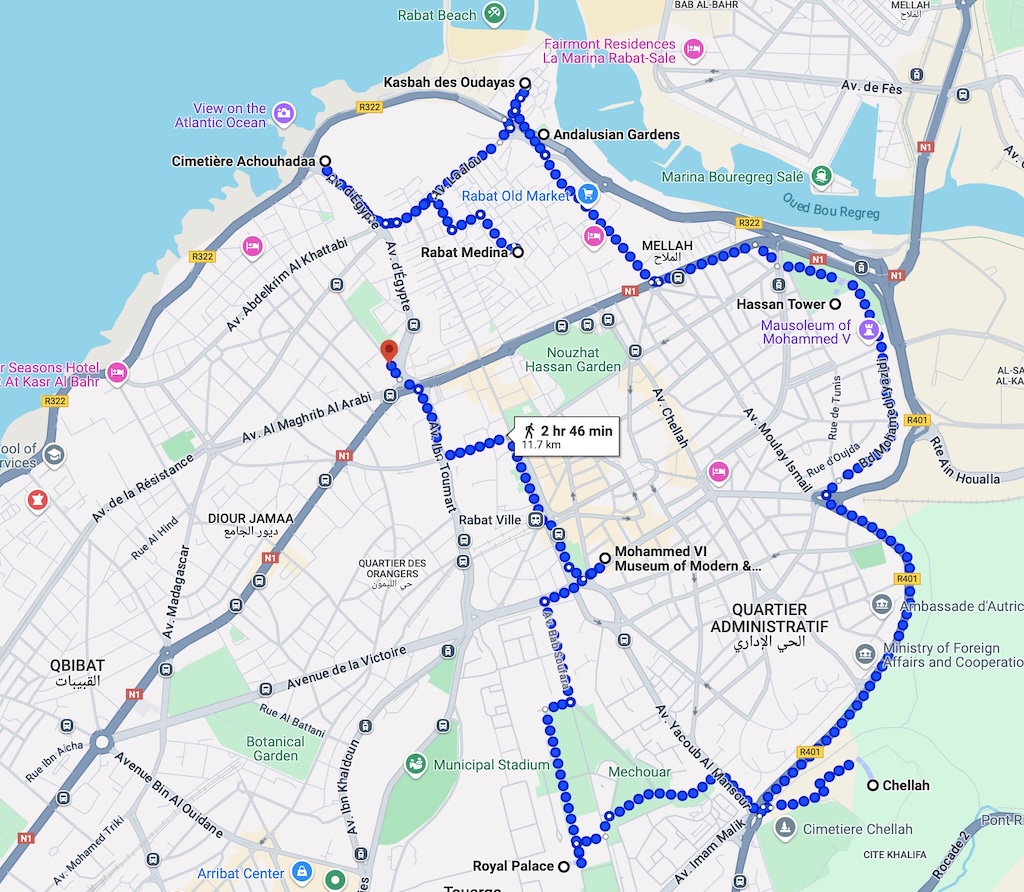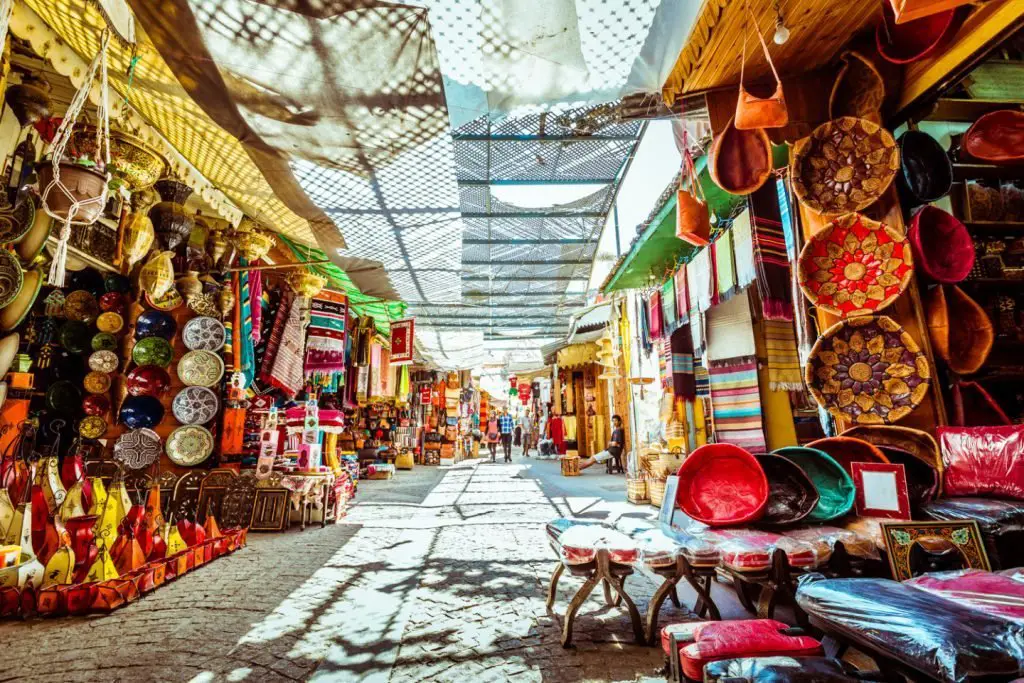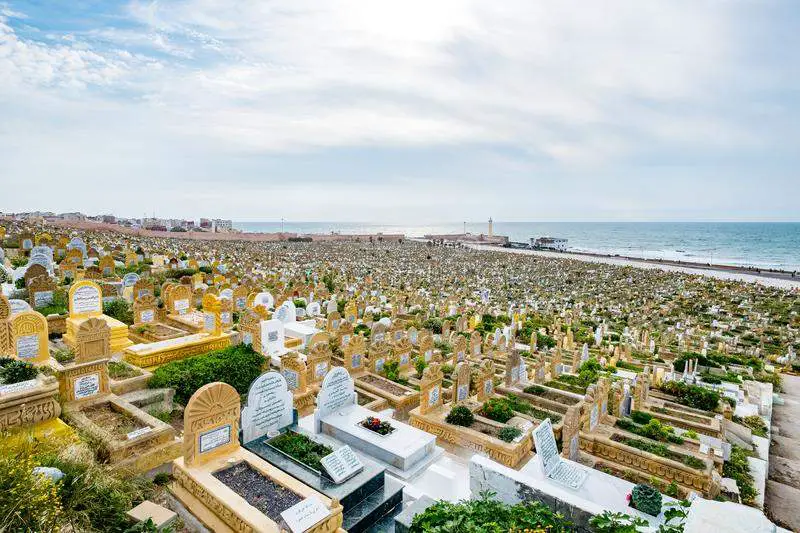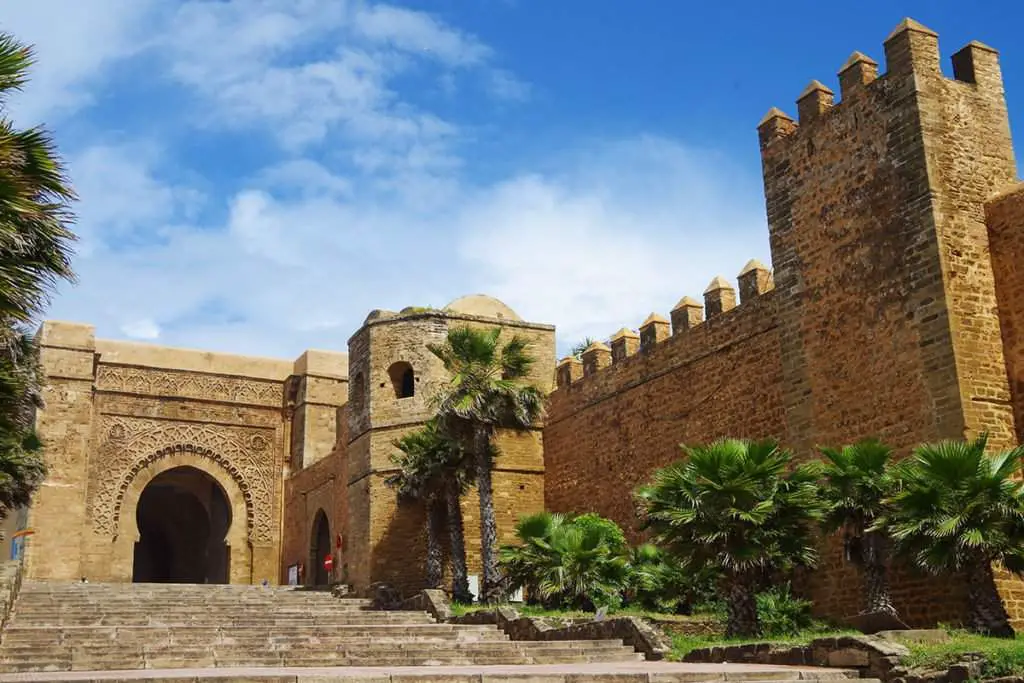Standing at the crossroads of ancient and modern Morocco, Rabat captivates visitors with its unique blend of imperial grandeur and laid-back coastal charm. For travelers wondering how much time to spend in Rabat, a single day offers an authentic taste of this underrated gem. Unlike its more famous siblings Marrakech and Fez, Morocco’s capital city promises a perfect one day itinerary where centuries-old traditions seamlessly merge with contemporary life.
From the haunting beauty of the incomplete Hassan Tower to the artistic vibrancy of Museum Mohamed VI, Rabat reveals its treasures at an unhurried pace. Whether you’re searching for things to do in Rabat in a day or the best beach in Rabat, this coastal capital delivers.
The city’s attractions tell a fascinating story of Morocco’s evolution, from Roman settlements to Islamic dynasties, colonial influences, and modern artistic expressions, all accessible through carefully selected activities to do in Rabat that maximize your limited time.
Here is the map for your 1 day itinerary in Rabat:

Here are the best places to stay in Rabat.
Get the best deals and discounts on hotels here.
Medina of Rabat

The Medina of Rabat stands out as a calmer, more laid-back old town compared to its counterparts in Marrakech and Fez. Without the usual tourist crowds, visitors can experience authentic Moroccan daily life at a comfortable pace.
This historical district shows Morocco’s rich past through its winding streets and local markets. Unlike the often overwhelming atmosphere of other medinas, Rabat’s version maintains a peaceful character while still offering traditional charm. Here, you’ll find artisans working in their workshops, merchants selling handmade goods, and locals going about their daily routines.
Things to do in Rabat includes Rue des Consuls, the medina’s main shopping street, which presents some of the finest textiles and handicrafts in the city. For the best local experience, head to the medina early in the morning when vendors set up their stalls and the streets come to life. You’ll catch glimpses of residents buying fresh bread, spices, and daily necessities while artisans begin their work in small workshops.
Cimetière Chouhada

The Cimetière Chouhada offers a peaceful stop along Rabat’s coastal area. Set against the backdrop of the Atlantic Ocean, this cemetery presents a quiet space away from the city’s main tourist spots. The gentle sound of waves and occasional calls to prayer create a reflective atmosphere that captures Rabat’s spiritual side.
Walking downhill through the cemetery leads to several key attractions. The path connects to the Rabat Lighthouse, standing tall against the coastline. To the right, Rabat Beach stretches along the Atlantic, while the historic Rottemburg Fort sits nearby, adding to the area’s historical significance.
The cemetery’s location makes it an ideal connecting point between the city’s main sights. Its elevated position provides views of the ocean and surrounding landmarks, making it a worthwhile stop for those interested in seeing Rabat. The site remains largely untouched by tourism, maintaining its authentic character.
Kasbah of the Udayas

The Kasbah of the Udayas stands as a magnificent 12th-century fortress, with its narrow streets painted in striking white and blue tones similar to those found in Chefchaouen. From its high walls, visitors can take in sweeping views of both the Bou Regreg River and Atlantic Ocean, making it one of the top attractions in Rabat.
Built during the time of the Almohad dynasty, this historic fortification played a key role in protecting the city. Its strategic position at the mouth of the river made it essential for defending Rabat from naval attacks. Today, the Kasbah continues to be a living part of the city, with residents maintaining its traditional character.
Visitors should plan their trip to the Kasbah for the afternoon when the sunlight creates perfect conditions for photography. The famous Café Maure, situated within the fortress walls, offers traditional mint tea with stunning ocean views. Its location near other main sights makes it an ideal stop while touring Rabat’s attractions.
Andalusian Gardens
Located within the Kasbah of the Udayas, these gardens bring a sense of calm to the busy city. Rows of citrus trees and bending pathways create cooling shade, while colorful flowers add bursts of color throughout the space. Palm trees stand tall among the well-maintained plant beds, making this spot a perfect retreat from Rabat’s heat.
The gardens tell a story of Morocco’s past, built during French colonial times but showing clear Spanish-Moorish influence in their layout. The design mirrors the gardens found in southern Spain, with neat paths, bubbling fountains, and structured plant arrangements typical of Andalusian style.
Getting to the gardens is simple – they sit right inside the Kasbah walls and welcome visitors without any entry fee. Many people include this while exploring Rabat’s attractions, taking time to rest on shaded benches or stroll among fragrant orange trees. The gardens stay open throughout the day, offering a peaceful break from sightseeing.
Hassan Tower and Mohammed V Mausoleum

The Hassan Tower stands tall as an incomplete minaret from what was meant to be the world’s largest mosque. This sandstone structure reaches 44 meters high, showing the grand plans of Sultan Yacoub al-Mansour in the 12th century. Though the mosque project stopped after the Sultan’s death, the remaining tower displays the skill of ancient Moroccan builders.
Next to the tower sits the Mausoleum of Mohammed V, a stunning example of modern Moroccan building skills. White walls, green-tiled roof, and detailed marble work mark this final resting place of three royal family members. Guards in traditional dress stand watch at the entrance, adding to the site’s dignity.
Morning visits offer the best conditions to see these monuments. The early hours bring cooler temperatures and fewer visitors, making it easier to walk around and take photos. Both buildings welcome guests without charge, and their central location makes them easy to find while checking out Rabat’s main attractions. The open plaza between them provides clear views and photo chances, especially as the sun rises or sets.
Chellah

The ruins of Chellah present a unique blend of Roman and medieval Muslim architecture, where nature has gradually taken over the ancient structures. Storks now make their homes atop centuries-old columns, adding to the site’s distinctive character. The stone pathways wind through gardens and past crumbling walls, creating a peaceful setting for visitors.
This UNESCO World Heritage Site tells the story of Rabat through different time periods. The area started as a Roman trading post, later becoming an Islamic necropolis during medieval times. The remaining structures show both Roman foundations and Islamic architectural details, making it a rare example of merged historical periods in Morocco.
Located just 10 minutes by car from downtown Rabat, Necropolis Chellah in Rabat welcomes visitors daily from 9:00 AM to 8:00 PM. The entrance fee is 70 MAD for tourists. Its quiet atmosphere creates perfect conditions for taking photos, particularly of the ancient minaret and Roman ruins. The site’s location makes it easy to include while visiting other attractions in Rabat.
Royal Palace

The Royal Palace of Rabat stands as a prime example of traditional Moroccan craftsmanship. Though visitors cannot enter the palace grounds, the exterior offers plenty to admire. The massive brass doors, detailed tilework, and ornate gates showcase the skill of local artisans who created these architectural elements.
Guards in ceremonial dress stand watch at the entrance, adding to the palace’s regal atmosphere. The well-maintained gardens and courtyards visible from outside hint at the grandeur within. Green-tiled roofs and intricate carved stonework mark this as one of Rabat’s most impressive buildings.
Located in the New City district, the palace remains an active royal residence and administrative center. While exploring Rabat’s attractions, most visitors stop briefly to photograph the palace gates and facade. The surrounding area features wide, palm-lined boulevards that make for pleasant walks, with the palace providing a striking backdrop.
Museum Mohamed VI of Modern and Contemporary Art
The Museum Mohamed VI stands as Morocco’s first major institution focusing on contemporary art. Its bright, modern halls display works from both Moroccan artists and international creators, showing the range of current artistic expression in the country.
Inside the museum, visitors find a mix of paintings, sculptures, and installations that tell the story of Morocco’s artistic growth. The collection puts local artists in the spotlight while bringing in works from around the world, creating a space where traditional Moroccan art meets modern ideas.
The museum sits in the heart of Rabat, making it simple to reach while visiting Rabat’s attractions. Regular special shows bring fresh perspectives to the space, while the permanent collection gives visitors a solid look at Morocco’s art scene. The building itself catches attention with its mix of Moroccan architectural elements and modern design, reflecting the balance of old and new found in its art collection.
Oulja Craft Complex (Salé)
Across the Bou Regreg River in Salé, the Oulja Craft Complex brings together Morocco’s finest artisans under one roof. The complex houses numerous workshops where skilled craftspeople work with clay, metal, and other materials, maintaining centuries-old techniques passed down through generations.
This bustling center shows the continued importance of handmade goods in Morocco. Here, potters shape clay on traditional wheels, metalworkers hammer intricate patterns into brass and copper, and ceramic artists paint detailed designs on tiles. These crafts remain central to both Morocco’s cultural identity and its economic well-being.
Visitors can watch artisans practice their trades in real-time, seeing how raw materials become finished pieces. The complex offers a chance to buy directly from creators, with items ranging from decorative pottery to practical household goods. While the short trip to Oulja provides an authentic look at Moroccan craftsmanship away from typical tourist spots. Most workshops open early in the morning and continue work throughout the day.
Eating Moroccan Food in Rabat

Dar Naji Centre
Located near the Central Market, Dar Naji Centre offers tasty Moroccan dishes at reasonable prices. The restaurant features a pleasant first-floor terrace where guests can enjoy mixed skewers, chicken with flour paste, and meat with plums. A meal for three people costs around 160 Dhs (16 euros), including bread, water, and traditional Moroccan tea.
La Liberation
This budget-friendly café in the medina attracts mainly locals with its low prices. The menu includes simple but satisfying dishes like harira soup, kebabs, and fruit salad. A full meal with bread, drinks, and water costs about 89 Dhs (9 euros), making it one of the most affordable options in central Rabat.
Dar El Medina
Hidden on busy Souika street in the Medina, Dar El Medina provides a quiet courtyard setting away from the street noise. The restaurant serves high-quality Moroccan dishes including harira, vegetable couscous, and seafood. While more expensive at around 270 Dhs (27 euros) for a meal with drinks, the generous portions and peaceful atmosphere make it worth considering for those seeking a more upscale dining experience. Check out where to eat for more dining recommendations in Rabat.
Sleep in Rabat in a typical accommodation

As I said before, in my opinion to fully enjoy the bustle of the city it is best to stay in the Medina, in my case I slept in the Dar Yanis, a typical riad with a central courtyard around which the rooms are distributed. It was very well located and with breakfast, for 45 euros, which for being Rabat is great.
I think that with this you can get a good idea of the city, having visited in this one day route the most interesting points to see in Rabat.
Read More:
Best Bars in Rabat
Rabat in 2 Days
Where To Stay in Rabat
Necropolis of Chellah in Rabat
The Perfect Blend of History and Modern Life
Rabat stands as a testament to Morocco’s ability to preserve its rich heritage while embracing contemporary progress. The city’s attractions offer visitors a comprehensive journey through time, from ancient Roman ruins to medieval Islamic architecture and modern art galleries, all while maintaining an authentically Moroccan atmosphere.
Whether you’re exploring the blue-and-white streets of the Kasbah, contemplating history at the Hassan Tower, or discovering contemporary art at Museum Mohamed VI, Rabat rewards visitors with experiences that feel genuine and unrushed. This capital city proves that Morocco’s cultural wealth extends far beyond its more famous tourist destinations.